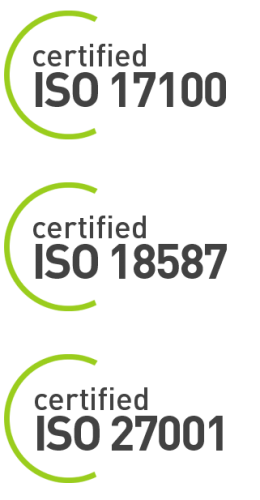Video/audio translations at comtexto
A far-reaching impact thanks to localised targeting
Whether on social media, at the point of sale, for employee training or e-learning – video is becoming more and more important alongside more traditional channels such as TV and cinema. In addition, the need for digitalisation due to the pandemic is providing an additional boost not only for the medium of video, but also for numerous podcast formats.
However, the principle that is generally true for addressing target groups – i.e. that they want to be spoken to in their respective mother tongue if possible – is even more true for video and audio.
But what about videos that are needed in several language versions? We will be happy to explain the advantages and disadvantages of dubbing, synchronisation or subtitling.


Video synchronisation
What is meant by this?
Video synchronisation generally means translating a video into other languages. Classic dubbing by means of voiceover and lip-sync also fall under the term video synchronisation. Subtitling is another form of language adaptation, although it is not the same as film synchronisation, which is when the original audio track is also replaced by an audio track in another language.
Lip syncing
Lip syncing is familiar to most people from film and television and represents the fine art of synchronisation. Ideally, the viewer should not be able to tell that a different language is spoken in the source video. However, even if special translators are used for lip syncing, usually with a dubbing director as well, it is not always possible to perfectly match the lip movements. It is not uncommon for it to be necessary to adapt the content of each language version in order to produce a lip-synchronous translation. The overall workload for lip-syncing is therefore quite high, but so is the positive effect on the target audience.
Dubbing via time synchronisation
The dubbing of a video actually refers to the complete sound of a film – i.e. sound effects, speech and music. When it comes to voice dubbing, there are other options besides lip-syncing. One of these is time synchronisation. Time synchronisation involves replacing the source language with a new language soundtrack. This option is cheaper than lip-syncing, but is also less efficient and is therefore not recommended.
Voiceover with original sound
The dubbing of a video actually refers to the complete sound of a film – i.e. sound effects, speech and music. When it comes to voice dubbing, there are other options besides lip-syncing. One of these is time synchronisation. Time synchronisation involves replacing the source language with a new language soundtrack. This option is cheaper than lip-syncing, but is also less efficient and is therefore not recommended.
Subtitling
In principle, subtitling is a simple and inexpensive type of language adaptation for videos. Nevertheless, there are a few things to bear in mind when subtitling. Translators who translate subtitles take great care to ensure that viewers can properly grasp the meaning of the subtitles while still being able to understand the images. We can also deliver subtitles in SRP format with a time stamp. In this way, the subtitles can be integrated directly into the video almost lip-synchronously. Subtitles have in fact become hugely important, since videos in social media are mostly soundless and a significant proportion of them are also watched without sound.
Your direct connection to us!
Are you already familiar with our customer portal mycomtexto? It allows you to easily submit and manage your translation orders.
mycomtexto offers you various advantages:

Certified quality and security
Highest quality and security standards
The multiple certification of our services guarantees the highest quality and security standards.
ISO 17100 certification ensures the evaluation of translation quality according to objective criteria, for example. The standard also specifies the skills and qualifications required by translators and revisers, in addition to other conditions.
Our ISO 18587 certification ensures that we meet the same high standards for post-editing as for human translation.
Thanks to ISO 27001 certification, comtexto is triple ISO certified. One thing is certain: your data is safe with us. This is because the ISO 27001 certification for information security is recognised worldwide. Among other things, it ensures that all aspects of risk management with regard to information processing procedures comply with the latest standards.

Do you have any questions about video and audio translations?
Your personal contact, Claudio Waldburger, will be happy to assist you:

